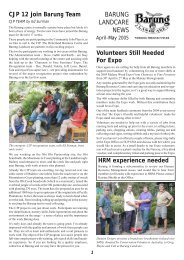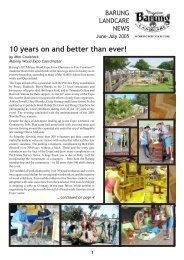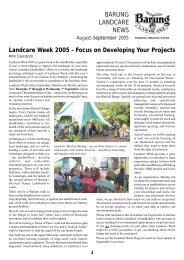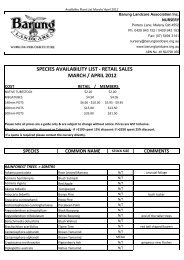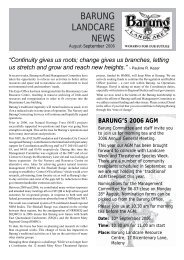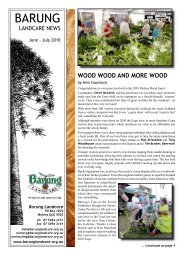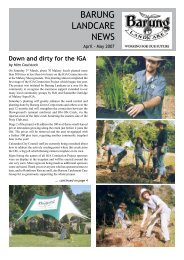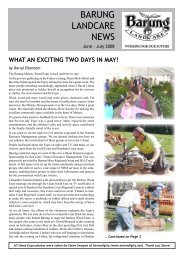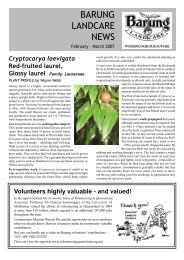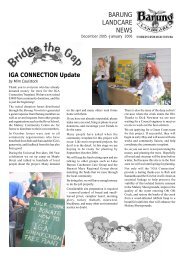June/July 2012 - Barung Landcare
June/July 2012 - Barung Landcare
June/July 2012 - Barung Landcare
You also want an ePaper? Increase the reach of your titles
YUMPU automatically turns print PDFs into web optimized ePapers that Google loves.
WINTER FLOWERS<br />
THE ORNAMENTAL GARDEN by Joan Dillon<br />
May and <strong>June</strong> in particular are tricky months in the ornamental<br />
garden. I love all the leafy shades of green but occasional splashes<br />
of colour are very welcome, especially on a cold overcast day. All<br />
is not lost however, as we do have some winter flowers for us to<br />
enjoy and to provide stand-by nectar for the birds. Occasional trees<br />
and shrubs are also bearing colourful fruit and buds are forming<br />
on the wattles, which is at least a promise of things to come.<br />
At ground level, there are still scattered flowers on the Scaevola<br />
aemula, and the commonly grown native violet Viola banksii<br />
continues to produce numerous flowers wherever it spreads. In<br />
case you haven’t caught up, Viola hederacea is in fact a different<br />
species and not the one we all grow. Goodenia ovata (the ground<br />
cover version) has its year-round scattering of yellow blooms and<br />
blue Cut-leafed Daisy, Brachyscome multifida, is flowering in the<br />
ground and in a pot. Lobelia membranacea which invariably pops<br />
up each winter has tiny pale blue flowers. Chrysocephalum apiculatum,<br />
Yellow Buttons, continues to flower and quietly spread.<br />
This one seems to change its name rather regularly and if you<br />
happen to Google Billy Buttons, another common name, you will<br />
come up with a different genus. The joys of plant nomenclature!<br />
Shrubs are not being particularly cooperative with flowers<br />
although a sprawling and supposedly local native member of the<br />
hibiscus family has been flowering freely. A small weak-stemmed<br />
plant, described as a suckering herb in Mangroves to Mountains,<br />
is Dampiera stricta from the Glasshouse Mountains. This small<br />
beauty has deep blue flowers.<br />
There are clusters of blue fruit on the large Callicarpa pedunculata,<br />
and Petalostigma triloculare is covered in ripening fruit<br />
BOOST TO REVEG AT<br />
PRECINCT<br />
by Steven Lang, Green Hills<br />
There have been some remarkable developments on the Maleny<br />
Community Precinct over the last few weeks. Firstly, Green Hills<br />
have received funding from Australia’s Clean Energy Biodiversity<br />
Fund to plant the entire north bank riparian zone between<br />
Maleny township and the existing forest. This is a strip almost<br />
two kilometres long and covers much of the area through which<br />
the proposed path to Gardners Falls will run.<br />
In the meantime Unity Water has signed a lease with Sunshine<br />
Coast Council to undertake the construction of linked wetlands<br />
and significant rainforest in the northern wetlands, otherwise<br />
known as Obi Obi Parklands area. The work by Unity Water will<br />
connect with the work of Green Hills.<br />
Green Hills attracted $175 000 worth of funding which they will<br />
match with other contributions of $125 000 from Lake Baroon,<br />
SEQ Water, Sunshine Coast Council and <strong>Barung</strong>.<br />
This is the second grant Green Hills has received this year and<br />
the brings the total funding for this riparian strip to $345 000.<br />
The project is planned to be undertaken over three years, starting<br />
immediately, with the budget including on-going maintenance of<br />
the plantings.<br />
Unity Water’s plan will cost $3 million, involves 30 ha, and will<br />
be undertaken in a similar time-frame. They will be upgrading the<br />
sewage treatment plant over the next eighteen months and want<br />
the basic planting, pipework, pathways, etc, to be in by that time.<br />
which will soon be orange-red. These two, however, are more<br />
suited to the edge of the revegetation. For those of you who live<br />
closer to the coast, Hibiscus tiliaceus is flowering.<br />
Fortunately, Syzygium luehmannii is sporting new and colourful<br />
foliage so there is always some colour around to help brighten<br />
the garden. Banksias are of course very reliable with Banksia<br />
integrifolia coming into flower now, Banksia robur always having<br />
a few flowers, and Banksia aemula to follow soon.<br />
Much will depend on where you are as to what is actually flowering<br />
now but there are numerous buds on both Acacia hubbardiana<br />
and Phebalium woombye, two very useful shrubs. Plant these<br />
reliable winter bloomers where you can see them and preferably<br />
in numbers to create a real splash.<br />
A carpet of Viola banksii in flower. [Photo: John Dillon]<br />
FAREWELL TO BRIAN BOON<br />
by Jonathan Waites<br />
Brian recently completed his Green Army placement with us and<br />
his extensive experience in construction has been of immense<br />
value to us, particularly in furthering the Landsborough project.<br />
His motivation and innovativeness has been much appreciated and<br />
has assisted us in completing a number of tasks to a high standard.<br />
At the Green Army graduation ceremony held at Mary Cairncross<br />
Park, Brian expressed his appreciation to Hinterland Business<br />
Centre for the opportunity to undertake the program, and to<br />
<strong>Barung</strong> <strong>Landcare</strong> for the chance to develop a greater connection<br />
with and appreciation of the natural environment.<br />
I would like to thank Brian for all his help and wish him all the<br />
best for the future.<br />
‘GARDENING ON THE EDGE’<br />
It may have been a wet weekend but there were a good number<br />
of visitors to the High School Activities Centre and many stopped<br />
by the <strong>Barung</strong> Display to ask questions, seek advice about plant<br />
species, purchase themed carry bags of tubestock, and learn more<br />
about the Hinterland Bush Links project.<br />
It’s always helpful to put ‘your’ place in the big picture and<br />
several visitors took advantage of the opportunity to locate their<br />
properties on the large regional map we displayed. All agreed that<br />
connecting pieces of protected habitat is a great idea. The focus<br />
of the display, HBL, connected <strong>Barung</strong> and our plant nursery to<br />
a wider audience, which can only help the environment.<br />
7



